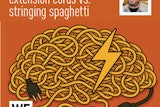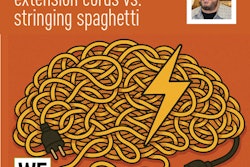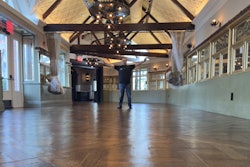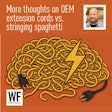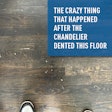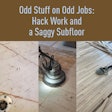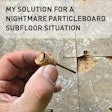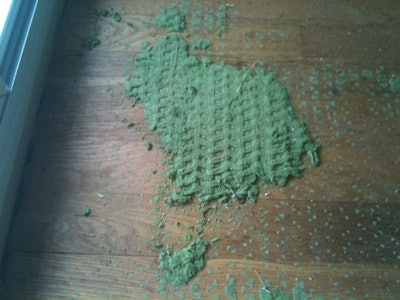
OK, now that I have your attention, let’s discuss what I think is the bane of all flooring material: wall-to-wall carpeting (WTWC). I don’t think there has ever been a more disgusting material manufactured that can be put over a wood floor. I’m on a mission to expose it for the flawed material it is and I’m hoping you will join me in my crusade. For starters, here’s a partial list of some of the failures of this wretched product:
- It traps moisture, and I’m not talking about just spills. When moisture comes in the house, any textile product in the room absorbs it. Most release it quickly, but not WTWC if it’s on a wood floor.
- Wood floors stand a much better chance of avoiding animal urine damage without WTWC. Here again, it traps this caustic and damaging liquid and holds it in direct contact with the wood floor, ensuring damage.
- It’s the best petri dish you can have in your home to grow molds and mildew.
- It’s the only flooring material with an invasive insect named after it—carpet mites.
- It traps dust, pollen and other airborne particulates. The first advice a doctor gives to someone suffering from allergies or any respiratory issues is to, “Rip out the carpet.”
- It’s one of the nastiest materials you’ve ever removed from a house. I love seeing the look on people’s faces when they see the dirt, grime, filth and family of silverfish mounded underneath when it comes out.
- Carpet pads often decompose and, like any decomposing material, often leave precious bodily fluids in the wood.
- The fact it sits in landfills without decomposing for years tells you all you need to know about its long-term effects on the environment.
- Its mere installation often leads to permanent and unsightly damage from countless staples and tack strips, and over-zealous installers with a utility knife in their hands.
- Its notorious off-gassing often has office workers and homeowners wearing the latest in hazmat fashions as they file out the door hacking their lungs out with their eyes tearing up and reddening.
And that’s only a partial list.
As I’ve recently seen, and listed above, some of the most telling and permanent damage from WTWC comes with its installation.
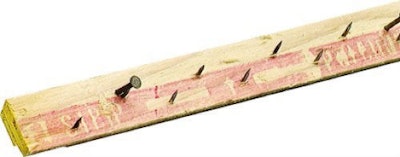 The infamous tack strip.
The infamous tack strip.
The tack strip is a nasty piece of work and could double as a medieval torture device. It’s attached to the floor around the perimeter of the room with a ribbed shank nail for secure holding and on the top surface has small sharp teeth to hold the carpet in place. If you’ve ever removed these items, you quickly learn two things: Those sharp teeth have a nasty bite, and that ribbed shanked nail can pull up hunks of wood.
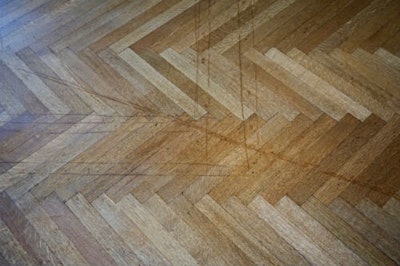 Cut marks from fitting carpet pads in office cubicles when an old historic house was used for offices.
Cut marks from fitting carpet pads in office cubicles when an old historic house was used for offices.
The lazy installer often adds insult to injury. As opposed to measuring and fitting the carpet pad, it’s often brought into the room and roughly cut in place. When the lazy installer takes his razor knife and carves through the pad, he often cuts into the floor as well. This leaves a deep incision in the wood around the perimeter and in center sections where additional fitting takes place. As is often the case, over time, moisture seeps into the incision and develops water staining.
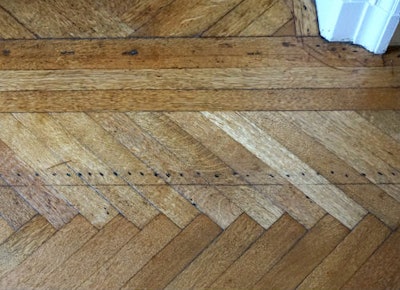 The smallest amount of moisture will add water staining to the equation.
The smallest amount of moisture will add water staining to the equation.
For the wood flooring contractor who follows this type of sloppy work, getting these marks out often proves problematic. First of all, the amount of sanding needed can go up substantially. But often times, that still doesn’t mitigate the issue, as the water stain from the incision or rust stains from the nails is much deeper. Excessively sanding a floor serves no other purpose than to weaken the floor and often leads to cracking and splitting of the wood.
Installing WTWC over a wood floor is just a bad idea. Put it over plywood, particleboard or concrete, as the damage to the substrate will be minimal. I don’t sell or install the stuff, but I’m often asked my opinion about it, and that’s when the gloves come off. It’s not just a matter of protecting an old wood floor. The case I argue revolves around the health and hygiene issues.
Homeowners need to know the truth about this insidious piece of textile and they rarely get it from people selling or recommending it. So don’t hold back if you can put your two cents in the conversation. I’ve cut my talking time in half by using the “underwear for your floor” analogy, and I make sure they know that’s it underwear you can’t take off. Just throw it out there and watch the reaction you get. Priceless.










